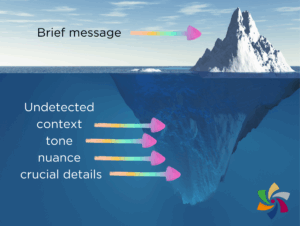Brevity blindspots: why communication shortcuts won’t ‘keep it short’ in the long run
The brevity of social media-style communication can create significant ‘blindspots’ that obscure meaning and ultimately cost far more than the time saved.
If you’re reading this post, you’re no stranger to workplace miscommunication. You’ve likely observed that in the rush to be concise, clarity can be compromised.
Maybe you’re a Learning and Development Manager who’s expected to find training solutions to the problem of miscommunication.
Bosses complain about information overload and lack of time to read documents, so they want you to make sure everyone else learns how to write concisely. But what does that mean? Just writing fewer words? Passing over punctuation? Machine-gunning bullet points?
The difference between brevity and concision is not well-understood. Instead of writing and editing skilfully for clarity and concision, message senders expect texting-style ‘shortcuts’ to do the job, e.g. abbreviations, emojis, and multiple one-line pings instead of one longer message.
This approach assumes the reader will ‘get’ what the writer means quickly. Yet, the room for misinterpretation is enormous, often with serious consequences.
Brevity can cause Titanic-like turmoil. What can you do to mitigate this kind of miscommunication? I’ll share some ideas, but let’s start with understanding the problem better.
The brevity paradox
The digital revolution has fundamentally altered how we communicate. Social media platforms, messaging apps, and collaboration tools like Slack and Teams have trained us to value brevity above all else. We abbreviate, truncate, and compress our thoughts to fit smaller screens and shorter attention spans. The pervasive influence of instant messaging cannot be ignored.
Research by Gligorić, Anderson, and West confirmed this shift in their study Causal Effects of Brevity on Style and Success in Social Media. They noted that “short messages are well-suited to small screens, and images with few words in large text are often shared widely.”
Similarly, the Pew Research Center’s study on The Future of Digital Spaces and Their Role in Democracy found that the migration to mobile devices has accelerated our preference for shorter, more visually-oriented communications.
Brevity, sometimes interpreted as concise communication, offers clear benefits, like:
- Better readability on mobile devices – short, easily digestible messages are crucial for effective communication on smaller screens
- More engagement with key messages – quicker to read and easier to understand messages are more likely to be acted upon, particularly in fast-paced environments
- Improved clarity – concise communication forces the distillation of ideas, removing the details that don’t matter.
- Reduced cognitive load for busy professionals – time and effort savings for both writer and reader.
But what happens when we apply digital communication styles to complex workplace interactions? Brevity can backfire, and the results may cost more than what’s saved.
When business communicators, especially ‘digital natives’, confuse brevity with concision, they often make these mistakes:
- Eliminating context that readers need to understand the implications
- Using ambiguous abbreviations and personal shorthand
- Omitting crucial details that impact decision-making
- Relying on emojis to convey complex emotions or intent
- Sending multiple fragmented messages instead of one complete thought
Concise writing means constructing sentences carefully with deliberate word choices and correct punctuation – focusing not on the word count but on making every word count, so your reader is in no doubt about what you want them to know.
And they’re not blindsided by the proverbial berg beneath the surface.
Misplaced brevity’s business impact
Productivity erosion
When project communications lack context, a team can waste hours pursuing misaligned objectives. That means missed deadlines, redoing the work, and readjusting the budget. Research from McKinsey Global Institute estimated that employees spend as much as 28% of their workweek managing email and nearly 20% searching for internal information or tracking down colleagues who can help. That’s a lot of time spent clarifying ambiguous communications.
Profitability hits
A SIS International Research study found that a business with 100 employees spends an average of 17 hours per week clarifying communication, which translates to an annual cost of $528,443.
Dud decision-making
Critical nuances omitted from reports or analyses lead to flawed decisions, often with far-reaching consequences. A single missing data point could reshape an entire strategy.
The tone trap
Without vocal intonation and facial expressions, brief written messages can come across as cold, dismissive, or even hostile. A message intended as efficient might be perceived as uncaring (my pet hate: ‘Noted with thanks’). The Journal of Personality and Social Psychology published a study titled Egocentrism Over Email, which found that people overestimate their ability to communicate effectively via email by more than 50%. The senders believed their tone would be correctly interpreted, but the recipients frequently misunderstood it.
Relationship ruin
Brief client communications lacking personalisation or detail can signal indifference, eroding trust and potentially jeopardising relationships.
Compliance and legal vulnerability
Abbreviated policy documents or instructions create dangerous interpretation gaps, exposing organisations to significant liabilities around service delivery and workplace health and safety.
Team disenchantment
Consistently receiving terse, context-free communications makes people feel undervalued and disconnected. Gallup’s State of the Global Workplace report tells us that poor communication is a major contributor to employee disengagement. Companies committed to high-quality internal communications, however, enjoy 41% lower absenteeism and 21% higher productivity.
Balancing brevity with effectiveness
Here are 5 ways you could approach the ‘brevity versus concision’ problem.
- Redefine concision when talking about communication
Encourage managers and team leaders to be specific about what they mean when they say ‘be concise’ – is it half a page or 100 words with a diagram? Replace ‘keep it short’ with ‘make every word count’. - Develop communication guidelines
Create protocols for when to use different communication methods and what level of detail is appropriate for each. For example, help employees understand that an email might require more context than a chat message (developing team-based communication protocols is a popular activity in my True Colors workshops). - Foster fair feedback
Establish processes that allow individuals and teams to safely provide input on communication effectiveness without fear of criticism. - Invest in business writing workshops
Look for programs that address the nuanced skills of balancing clarity with concision, selecting appropriate tone, and crafting messages with intention. Effective communication training offers one of the highest ROIs of any L&D investment. - Aim for audience-centred writing practices
Ensure any business writing training includes identifying what information is truly essential to the reader’s understanding and decision-making. This includes considering their knowledge base, information needs, and potential interpretation before sending communications.
When your teams communicate with precision, purpose, and empathy, you’ll see tangible positive impacts, like:
- Faster project completion with fewer iterations and missed deadlines
- More aligned and engaged teams working toward common goals
- Stronger client relationships built on reliable understanding
- Reduced risk of costly misunderstandings
- Higher employee satisfaction and talent retention
The digital transformation of communication isn’t reversing, but your organisation can learn to navigate it skilfully with the right training.
If you’re ready to invest in concise business writing skills for your people instead of wondering what’s happened to your productivity and profitability, book a complimentary, unconditional Tell Me More call.



